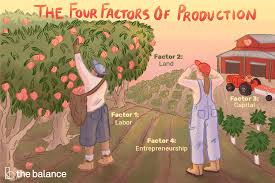Factors of production are the inputs needed for the creation of good products or services. The factors of production include land, labor, entrepreneurship and capital.
The modern definition of factors of production is primarily derived from a neoclassical view of economics. It amalgamates past approaches to economic theory, such as the concept of labor as a factor of production from socialism, into a single definition.
The 4 Factors of Production
The four factors of production are land, labor, capital, and entrepreneurship. They are the inputs needed for supply. They produce all the goods and services in an economy. That’s measured by gross domestic product.
(1) Land
Land is short for all the natural resources available to create supply. It includes raw property and anything that comes from the ground. It can be a non-renewable resource. That includes commodities such as oil and gold. It can also be a renewable resource, such as timber.
Once man changes it from its original condition, it becomes a capital good. For example, oil is a natural resource, but gasoline is a capital good. Farmland is a natural resource, but a shopping center is a capital good.
The income earned by owners of land and other resources is called rent.
The United States is blessed with an abundance of easily accessible natural resources. These include fertile land and water. Many countries are covered with mountains or desert, making it expensive to use the natural resources. It has miles of coastline, lots of oil, and a moderate climate.
That’s an advantage over Canada. It has similar natural resources, but they are not always as accessible due to permafrost covering parts of the country’s land.
Climate change is beginning to change that, thawing permafrost in some areas and increasing access to oil and other natural resources. Climate change also will make it harder for Canada to utilize natural resources in some regions. It will reduce water supplies to its oil sands in Alberta, which may lead to a reduction in production.
Read Also: Essential Guide to Business Process Mapping
(2) Labor
Labor is the work done by people. The value of the workforce depends on workers’ education, skills, and motivation. It also depends on productivity. That measures how much each hour of worker time produces in output.
The reward or income for labor is wages.
The United States has a large, skilled, and mobile labor force that responds quickly to changing business needs. It also benefits from productivity increases due to technological innovations.
On the other hand, the U.S. labor force faces increasing competition from other countries. That’s one reason why American jobs are being outsourced.
The Bureau of Labor Statistics measures the U.S. labor force. It releases the current U.S. jobs report the first Friday of each month. The report includes the employed and the unemployed. The employed only include people over 16 who worked in the past week.
It excludes the active military and any residents of an institution. The unemployed are those who actively looked for a job in the past month. All the other jobless are not members of the labor force.
(3) Capital
Capital is short for capital goods.These are man-made objects like machinery, equipment, and chemicals that are used in production. That’s what differentiates them from consumer goods.
For example, capital goods include industrial and commercial buildings, but not private housing. A commercial aircraft is a capital good, but a private jet is not.
The income earned by owners of capital goods is called interest.
The United States is a technological innovator in creating capital goods, from airplanes to robots. That’s why Silicon Valley is a critical comparative advantage in the global market.
The U.S. Bureau of the Census releases information on capital goods production with the monthly durable goods orders report. It reports on total capital goods order, shipments, and inventory. It also strips out defense and transportation.
Those orders come in large batches. It can hide the real trends. Capital goods production has declined since the Great Recession. Demand for them hasn’t returned to the same levels.
As a result, companies aren’t investing in new equipment. They are buying back stock shares, purchasing new businesses, and looking for opportunities overseas.
(4) Entrepreneurship
Entrepreneurship is the drive to develop an idea into a business. An entrepreneur combines the other three factors of production to add to supply. The most successful are innovative risk-takers.
The income entrepreneurs earn is profits.
The majority of entrepreneurs in the United States own small businesses. There are 30.2 million small businesses in the United States, and 47.5% of employees work for a small business.
One reason small businesses do so well is that it’s relatively easy to get funded compared to other countries. Others raise money on the stock market by issuing an initial public offering. Shares in these companies are called small-cap stocks.
Read Also: Business Process: Definition, Life Cycle, Steps and Importance
Ownership of the factors of production depends on the type of economic system and society.
| Factors of Production | Socialism | Capitalism | Communism |
|---|---|---|---|
| Are owned by | Everyone | Individuals | Everyone |
| Are valued for | Usefulness to people | Profit | Usefulness to people |
Capital finance is sometimes called the fifth factor of production. But that’s not accurate. Money facilitates production by providing income to the owners of production.
